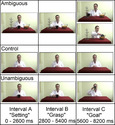Highlight
Using EEG and machine learning to predict action goals
Achievement/Results
An end goal of our IGERT training program is to design technologies that can help older adults retain functional independence. IGERT trainees Lawrence Behmer and Jason Fairey are designing brain-machine interfaces to provide older adults with robotic assistance in executing motor actions when it is needed for them to perform critical activities. To do this, a first step is to detect the action that an individual intends to perform. The brain’s frontal-parietal mirror circuit (FPMC) is active when individuals observe or perform a goal-directed behavior. Evidence in macaques and humans suggest that the FPMC is extremely robust at the point when individuals select or comprehend the goal of a motor action, enabling an observer to understand the individual’s intentions. Recent theoretical hypotheses in the fields of computer science and machine learning suggest that data from the FPMC may have applications in robotics and artificial intelligence.
Recently, EEG data has been used to control brain-machine interfaces, move a cursor on a computer screen, and access a smart phone app. We used EEG to measure mu- and beta-ERD in left and right motor component clusters, while individuals observed and imitated an actor engaging in goal-directed actions where the outcomes were either ambiguous or unambiguous. We employed machine learning algorithms to test our hypothesis that they can classify single trial EEG data to determine if participants were observing an action or were observing non-movement controls, as well as discriminating between ambiguous or unambiguous goals. To validate our hypothesis, we recruited 16 right-handed participants to observe 96 ambiguous goal videos, 96 unambiguous goal videos, and 48 non-action videos. EEG data was collected during the study. Data was run through a wavelet analysis to isolate frequencies with the strongest signal-to-noise ratio. Experiments were then run to determine how well a naive Bayes classifier could distinguish ambituous from un-ambiguous goals and to determine the point at which the goal was recognized. An average accuracy of 80% was achieved for these experiments.
Address Goals
These results are discussed in the context of developing a hands-free, non-invasive neural devices that can assist senior citizens with mobility impairments in a smart home environment. The use of EEG in BMIs to discriminate between brain activity during action planning and observation is critical for the development of non-invasive devices that could be used to detect falls. In order to minimize errors, BMIs would need to be sensitive not just to movement, but a host of other cognitive processes associated with motor activity such as action perception. Not only is this research project central to the theme of our IGERT training program, but it represents a cross-disciplinary effort among our trainees. Lawrence Behmer is a PhD student in Experimental Psychology and Jason Fairey is a Computer Science student. Before this IGERT program t hey were unaware of research in each other’s fields. Since starting to work on this joint project they have taken additional classes to become familiar with work in the complementary disciplines and have refined their skills to be able to talk to researchers in diverse audiences.








